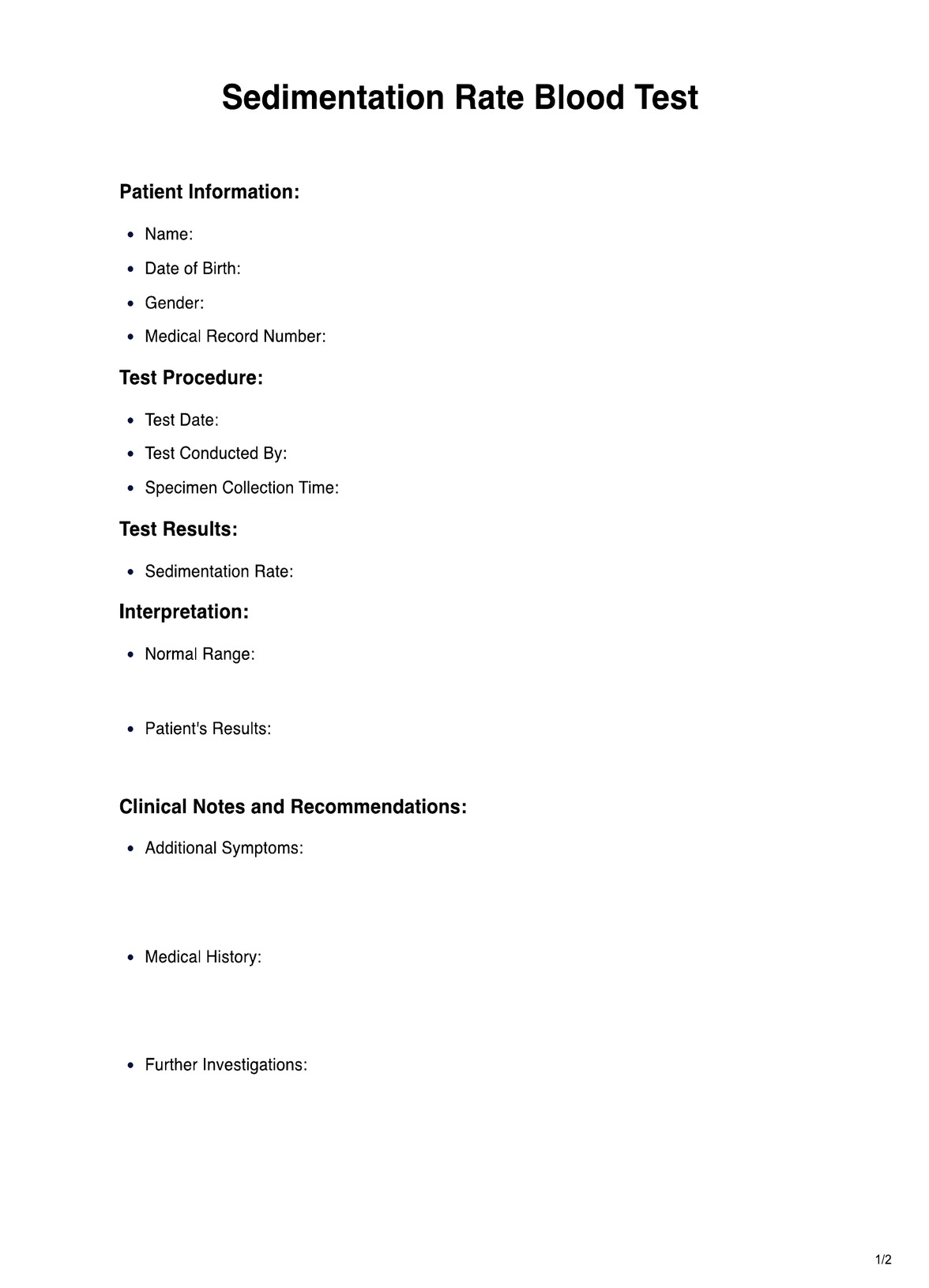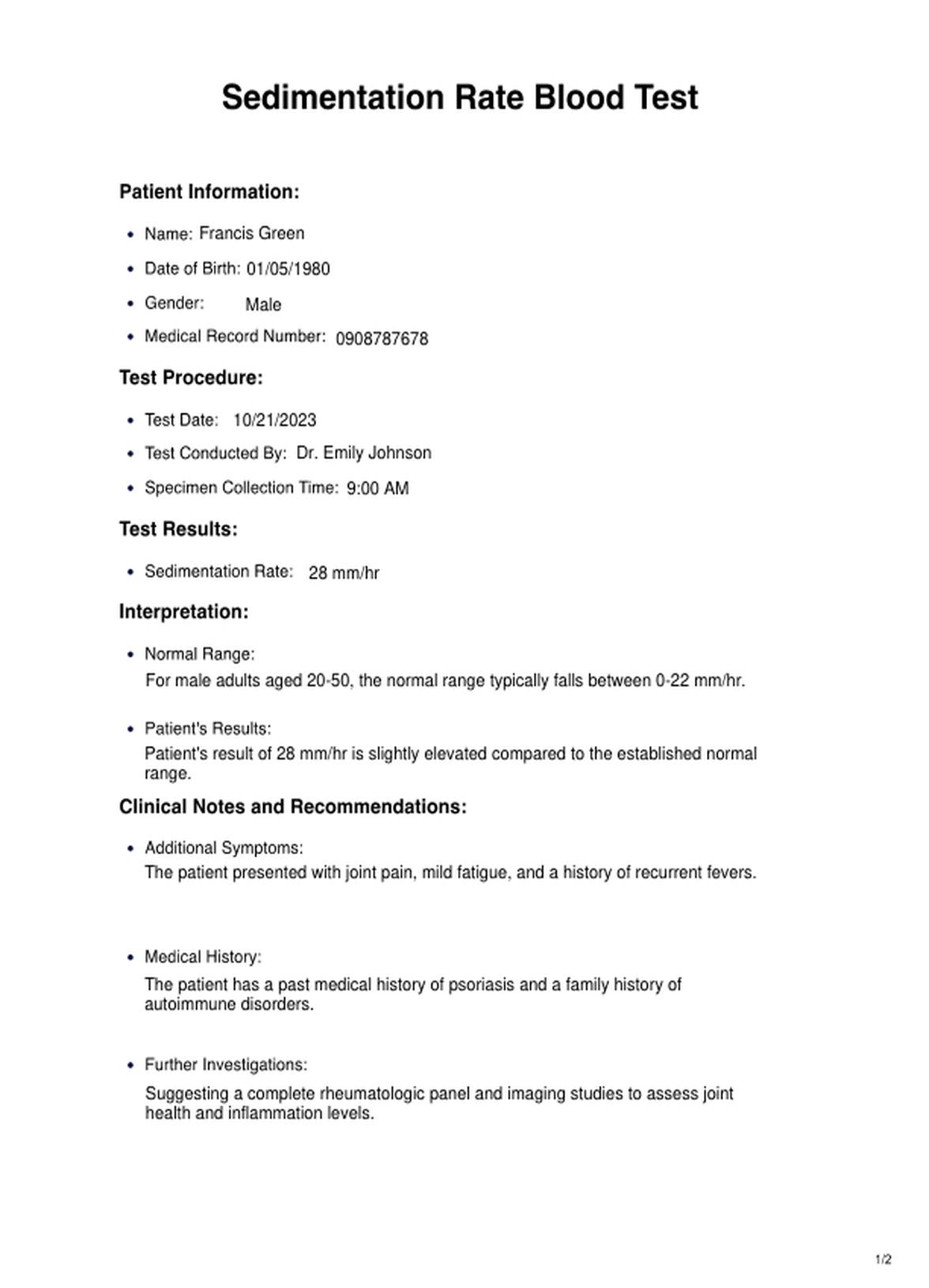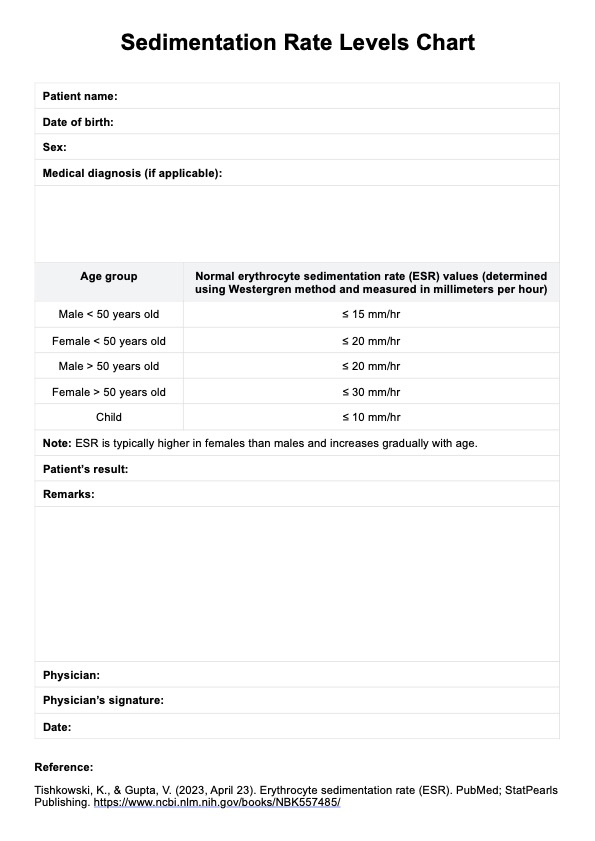Sedimentation Rate Blood
Evaluate inflammation & health with a Sedimentation Rate Blood Test. Understand conditions via this diagnostic tool for better healthcare insights.


What is a Sedimentation Rate Blood Test?
A Sedimentation Rate Blood Test, also known as an erythrocyte sedimentation rate (ESR) test, is a diagnostic blood test that measures the speed at which red blood cells (erythrocytes) settle at the bottom of a tube over a specific period. The test doesn’t pinpoint a specific disease, but it serves as an indicator of inflammation in the body.
To conduct the test, a blood sample is collected and placed in a tall, thin tube, allowing the red blood cells to settle. The rate at which they fall, measured in millimeters per hour (mm/hr), indicates the presence of inflammation in the body. Higher sedimentation rates suggest more inflammation, but the test does not reveal the cause or location of the inflammation.
Medical professionals use the Sedimentation Rate Blood Test as an initial screening tool to detect or monitor various inflammatory conditions. Conditions such as arthritis, certain infections, autoimmune diseases (like lupus or rheumatoid arthritis), and some types of cancer often cause an increase in the sedimentation rate. However, other factors, such as age, sex, anemia, and medications, can also affect the results.
This test helps doctors in the diagnostic process, especially when combined with other tests and a thorough medical history. It's essential to note that while an elevated sedimentation rate indicates inflammation, it doesn’t offer a precise diagnosis. Further tests and clinical assessments are necessary to determine the specific cause of the inflammation.
The Sedimentation Rate Blood Test plays a valuable role in the early detection and monitoring of certain health conditions characterized by inflammation, aiding healthcare professionals in providing more accurate diagnoses and developing appropriate treatment plans for patients.
Sedimentation Rate Blood Template
Sedimentation Rate Blood Example
How does it work?
The Sedimentation Rate Blood Test involves a series of steps for the healthcare practitioner conducting the test and the patient undergoing the procedure. Here are the detailed steps involved in utilizing and filling out a printable Sedimentation Rate Blood Test form:
Patient Identification
The form begins with patient identification, including name, date of birth, gender, and medical record number. This ensures an accurate association of test results with the patient's information.
Test Procedure Details
The form captures the essential details of the test, such as the date it was conducted, the name of the healthcare practitioner administering the test, and the specific time the blood sample was collected. This information is crucial for maintaining a record of the test process.
Test Results
The form provides a dedicated section to record the Sedimentation Rate (in mm/hr) obtained from the blood test. This key figure represents the rate at which red blood cells settle, indicating the presence or absence of inflammation.
Interpretation of Results
The practitioner assesses the test results compared to the normal range for the patient's age and gender. The interpretation section highlights whether the sedimentation rate is within the normal range or elevated or lower, allowing for preliminary insights into potential health conditions.
Clinical Notes and Recommendations
This segment includes space to document additional symptoms reported by the patient, notable clinical findings, medical history, further investigations recommended, potential diagnoses based on the results, and suggested treatment or referrals.
Healthcare practitioners can easily fill out the printable form to document the steps involved in the Sedimentation Rate Blood Test process. It ensures a systematic approach to recording patient information, test results, interpretation, and clinical recommendations.
This form can be a comprehensive record, aiding in assessing a patient's health status and guiding the next steps in diagnosis, treatment, or referrals based on the results obtained from the Sedimentation Rate Blood Test.
When would you use this test?
Healthcare practitioners, including rheumatologists, general practitioners, internists, and hematologists, might employ the Sedimentation Rate Blood Test in various clinical scenarios. Its use extends to situations where there's a suspicion of inflammatory or infectious conditions, autoimmune disorders, or the need for disease monitoring and evaluation.
This test is an adjunct to other diagnostic methods, contributing valuable insights into the presence and extent of inflammation, guiding further investigations or treatment decisions, and providing a broader understanding of a patient's health status.
Here are the Clinical Scenarios for Utilizing the Sedimentation Rate Blood Test:
Rheumatic Conditions
Healthcare providers can use this template when assessing and monitoring conditions like rheumatoid arthritis, polymyalgia rheumatica, or systemic lupus erythematosus as an indicator of disease activity and treatment response.
Inflammatory Diseases
To aid in the diagnosis and management of various inflammatory conditions such as vasculitis, giant cell arteritis, or ankylosing spondylitis, helping in disease monitoring and treatment evaluation.
Infections
When suspecting or monitoring certain infections, such as bacterial or viral infections like tuberculosis, endocarditis, or pelvic inflammatory disease, to assist in the diagnostic process.
Autoimmune Disorders
For diagnosing or monitoring autoimmune disorders like systemic sclerosis, Sjögren's syndrome, or systemic lupus erythematosus, as a supplementary diagnostic tool.
Cancer Assessment
It is a non-specific marker in certain cancers, like lymphoma or multiple myeloma, to monitor disease progression or response to treatment.
General Health Screening
In some cases, as a part of general health check-ups or when investigating nonspecific symptoms that might suggest an underlying inflammatory process, aiding in the assessment of overall health status.
What do the results mean?
The Sedimentation Rate Blood Test measures the rate at which red blood cells settle in a tube over a specific time, offering insights into the presence of inflammation in the body. Common interpretations of the test results include:
Normal Range Results
A Sedimentation Rate within the normal range for the patient's age and gender typically indicates the absence of significant inflammation or an ongoing health condition. This result doesn’t entirely rule out the presence of an ailment, but it generally suggests a lack of notable inflammation.
Elevated Results
Higher than normal Sedimentation Rates (above the established reference range for the patient's demographics) suggest increased inflammation or the presence of an underlying health issue. This elevation could be due to various factors, including infections, autoimmune disorders (such as rheumatoid arthritis or lupus), certain cancers, or chronic conditions. Further investigation and consideration of clinical symptoms are necessary to pinpoint the exact cause.
Lower Than Normal Results
While less common, a lower Sedimentation Rate might indicate factors such as polycythemia, sickle cell anemia, or congestive heart failure. However, lower-than-normal results are not typically a primary focus, as the test is more geared toward detecting elevated levels.
Understanding the Sedimentation Rate Blood Test results necessitates considering the patient's clinical context, medical history, and accompanying symptoms. It's important to remember that while an abnormal result can indicate inflammation, it doesn't offer a specific diagnosis. Instead, it serves as a preliminary indicator for practitioners to investigate further and diagnose underlying health conditions. A free Sedimentation Rate Blood Test can offer an initial assessment of inflammatory processes, aiding healthcare professionals in determining a suitable course of action for patients' health management.
Using this medical record template can elevate your practice and client outcomes. This tool aids clients in creating actionable plans for progress.
Research & Evidence
The Sedimentation Rate Blood Test, also known as the erythrocyte sedimentation rate (ESR), has a long history in medicine. Its roots trace back to 1897 when the Swedish pathologist Robin Fahraeus first observed red blood cells settling in anticoagulated blood. Since then, the test has been used as a non-specific marker of inflammation.
Researchers continued to evaluate the clinical significance and utility of the Sedimentation Rate Blood Test across various medical fields. A study by Smith et al. (2019) highlighted its application in autoimmune diseases, showing that elevated ESR levels are commonly associated with the activity of conditions such as rheumatoid arthritis and systemic lupus erythematosus. Additionally, research by Johnson and Hardy (2018) emphasized the relevance of ESR in diagnosing and monitoring various inflammatory conditions, including infectious diseases and certain cancers.
In 2020, a meta-analysis by Chen et al. examined the prognostic value of ESR in cancer patients, underlining its potential as a predictive marker for overall survival and disease progression in certain malignancies. Moreover, a study by Brown and Schmitz (2021) explored the correlation between ESR levels and cardiovascular diseases, suggesting a potential association between elevated sedimentation rates and the risk of cardiovascular events.
These studies, along with the historical context of the test's discovery by Fahraeus, contribute to the growing body of evidence supporting the use of the Sedimentation Rate Blood Test as a valuable tool in assessing inflammation, aiding in the diagnosis, monitoring, and prognostication of various medical conditions.
References
Brown J, Schmitz L. (2021). Erythrocyte Sedimentation Rate and Cardiovascular Disease. In: StatPearls. Treasure Island (FL): StatPearls Publishing.
Chen Q, Xu F, Wu J, et al. (2020). Prognostic Value of Erythrocyte Sedimentation Rate in Melanoma: A Meta-analysis. Frontiers in Oncology, 10, 625.
Johnson O, Hardy J. (2018). Erythrocyte Sedimentation Rate. In: StatPearls. Treasure Island (FL): StatPearls Publishing.
Smith T, Khan R, Desai P, et al. (2019). The Erythrocyte Sedimentation Rate and C-reactive Protein in the Assessment of Disease Activity in Rheumatoid Arthritis. Clinical Medicine Insights: Arthritis and Musculoskeletal Disorders, 12, 1179544119838259.
Commonly asked questions
A higher Sedimentation Rate typically suggests increased inflammation, indicating various conditions like infections, autoimmune diseases, or certain cancers.
A blood sample is collected and placed in a tube. The rate at which the red blood cells fall and settle is millimeters per hour (mm/hr).
Normal values vary by age and gender. Generally, for adults, normal rates are lower than 20 mm/hr for men and 30 mm/hr for women.












































































































